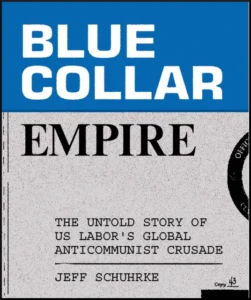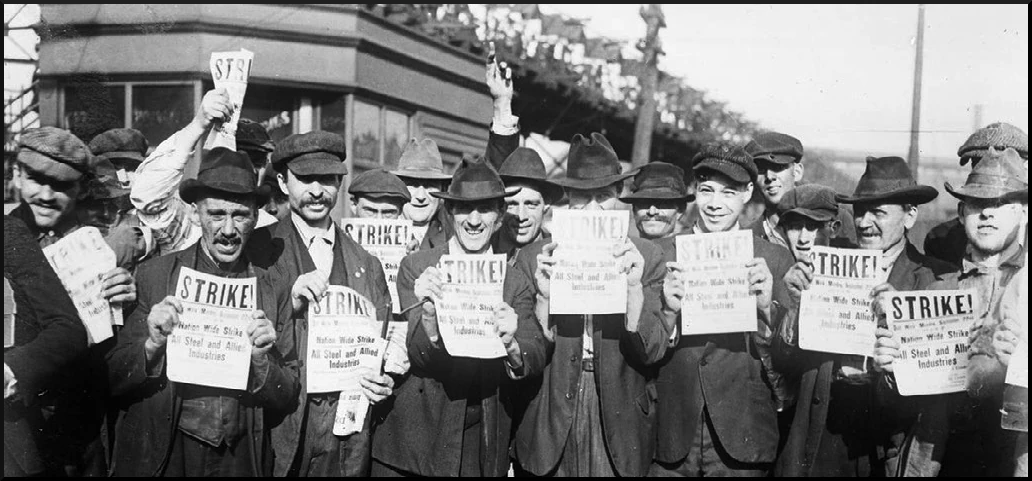by Book Review by Jonathan Kissam, published on Labor Today, September 1, 2024
 The Untold Story of US Labor’s Global Anticommunist Crusade, by Jeff Schuhrke: After unions won historic gains for working people in the strike wave that followed the end of World War II, corporations like General Electric and Westinghouse sought to weaken the labor movement. By labeling militant unions like UE (United Electrical Workers Union) as “red” or “communist-dominated,” they were able to recruit not only the government but also many union leaders to their cause. The ensuing wave of red-baiting and raiding not only nearly destroyed UE, it had a chilling effect on militancy and political independence throughout the whole U.S. labor movement.
The Untold Story of US Labor’s Global Anticommunist Crusade, by Jeff Schuhrke: After unions won historic gains for working people in the strike wave that followed the end of World War II, corporations like General Electric and Westinghouse sought to weaken the labor movement. By labeling militant unions like UE (United Electrical Workers Union) as “red” or “communist-dominated,” they were able to recruit not only the government but also many union leaders to their cause. The ensuing wave of red-baiting and raiding not only nearly destroyed UE, it had a chilling effect on militancy and political independence throughout the whole U.S. labor movement.
In his new book Blue Collar Empire the labor historian, journalist, and union activist Jeff Schuhrke documents how many AFL and CIO leaders not only participated in witch hunts against UE and other militant unions in the U.S., but actively conspired with the U.S. government to undermine militant unions around the world. Indeed, they were not only willing participants in the government’s crusade against so-called “communist” unions, but in some cases were even more enthusiastic about that crusade than the government itself.
“Free” Trade Unions
AFL-CIO leaders carried out this crusade in the name of what they called “free trade unionism.” They argued that militant, “communist-dominated” unions were not really fighting for the interests of their members, but were secretly working on behalf of foreign governments to impose a “totalitarian” political agenda. In contrast, they claimed, “free” trade unions like those in the U.S. were independent of government influence and a force for democracy.
As Schuhrke’s detailed history shows, however, the American Federation of Labor — which established a “Free Trade Union Committee” in 1944 to carry out its international work — had close ties with the U.S. government going back at least to World War I, when AFL President Samuel Gompers worked closely with President Woodrow Wilson and corporate leaders to suppress labor opposition to the war.
The FTUC (anti-communist committee of the AFL) scored its first major victory in the aftermath of World War II, when it successfully split the powerful French union confederation CGT during a series of strikes. It encouraged more conservative elements in the CGT to leave and form a rival federation, Force Ouvrière, providing them with direct financial assistance. In doing this, the FTUC helped defeat workers’ strikes for higher wages and strengthened the hand of the French government — a curious achievement for “free trade unionism.”
On the global stage, the FTUC set its sights on splitting the World Federation of Trade Unions. Founded in October 1945, the WFTU came out of the relationships developed between the CIO and British and Soviet unions during World War II, as the three countries were allied to defeat Hitler. It included the vast majority of the world’s labor federations. However, as the Cold War intensified, international cooperation between workers across political lines became seen as a communist conspiracy. In 1949, weeks after formally expelling UE, the CIO joined the AFL, the British Trades Union Congress, and Force Ouvrière in founding a rival global federation, the International Confederation of Free Trade Unions.
Schuhrke expertly guides the reader through the dizzying array of committees, confederations, agencies, institutes, centers and foundations set up by the AFL-CIO and the U.S. government over the decades to split (or directly suppress) militant labor movements and undermine pro-worker governments around the world. He also provides concise, and often heartbreaking, accounts of their “accomplishments” in various countries.
Perhaps the most significant of these was the American Institute for Free Labor Development, a training institute which focused on promoting “free trade unionism” in Latin America and the Caribbean. Founded in the early 60s, AIFLD’s board of trustees included numerous businessmen from U.S. corporations, and was chaired by J. Peter Grace, a wealthy capitalist whose family had financial interests in a wide variety of industries in the region.
Unsurprisingly, AIFLD was not enthusiastic about training Latin American workers to fight for higher wages in these industries — but they did train them to oppose pro-worker governments who might threaten those industries’ profits. Schuhrke details AIFLD’s interventions in Guyana, Brazil and the Dominican Republic, all of which contributed to the overthrow of democratically-elected governments and led to decades of authoritarianism and corruption.
Workers who were genuinely fighting oppressive governments, however, could expect less support from the AFL-CIO. One of the most tragic figures in Blue Collar Empire is Maida Springer, a Black woman from New York City who rose through the ranks of the International Ladies’ Garment Workers’ Union and eventually went to work at the AFL-CIO’s International Affairs Department, working with African workers and trade unionists. Springer seems to have been genuinely idealistic, seeing her role as improving the lives of African workers, not playing Cold War politics.
But in the case of South Africa — where communists and other leftists were prominent participants in the struggle against apartheid — Cold War politics prevailed. Springer’s efforts to get the AFL-CIO to develop relationships with the unionists who would form the Congress of South African Trade Unions, which was allied with the African National Congress and a key part of the anti-apartheid struggle, were unsuccessful.
Instead, the AFL-CIO preferred to support the anti-communist Mangosuthu Gatsha Buthelezi. Buthelezi, who was later revealed to be on the payroll of the apartheid government, formed a rival union which opposed strikes, boycotts, and divestment, and whose members violently attacked striking COSATU (Congress of South African Trade Union) members. The AFL-CIO did not endorse the South African freedom struggle until 1986.
(Meanwhile, a Black trade unionist from South Africa spoke at the 42nd UE convention in 1977; both the national union and many large locals, including Local 506, subsequently joined the call to divest from the apartheid government.)
Most works of labor history concern collective actions taken by large groups of workers. In contrast, the history of the AFL-CIO’s international involvement as related in Schuhrke’s book is primarily a history of individuals, mostly working behind the scenes, often engaged in clandestine and/or illegal activities. In France, AFL money was used to hire mobsters to beat up striking dockworkers. In China, “liberty-loving Chinese workingmen” were explicitly encouraged to engage in espionage and sabotage.
The most prominent of the individuals whose stories are told in Blue Collar Empire is the ex-Communist Jay Lovestone, who Schuhrke describes as “One of the most fascinating and unsavory characters in the history of US labor.” What qualified Lovestone for decades of work on the AFL and AFL-CIO payroll was not any expertise organizing workers, but his experience with Communist Party infighting in the 1920s. Indeed, it seems that few of the individuals who led the AFL-CIO’s international work had much experience with organizing workers, instead being drawn from the ranks of bureaucrats and self-styled cloak-and-dagger men.
Unsurprisingly, the rank-and-file union members in whose name these actions were ostensibly carried out rarely had any inkling of what was being done by their unions and their labor federations. As Schuhrke writes in his introduction, AFL-CIO officials pursued this course of action “without consulting the millions of workers they represented.” In these “free” trade unions, members had virtually no say over the actions their leaders took on the international stage.
Aiding and Abetting Corporate Globalization
In the final section of the book, “Free Market Revolution,” Schuhrke makes it clear what the consequences were for U.S. workers of the labor movement’s anticommunist crusade.
The section begins with an account of AIFLD’s role in the 1973 military coup that overthrew the democratically-elected government of Chile. Salvador Allende, a democratic socialist elected in 1970, had the backing of the country’s largest labor federation, the CUT, and during his first year in office, union membership expanded and real wages rose by 30 percent.
Needless to say, this upset the corporate AIFLD board members who owned stakes in Chilean industries. Although AIFLD was unable to dissuade any major sections of the CUT from supporting Allende, they provided lavish support to associations of professional workers, known as gremios in Chile, who engaged in a series of work stoppages meant, in part, to undermine the Allende administration. (During one such work stoppage, Schuhrke reports, the strikers told a correspondent from Time that the money for the “lavish communal meal of steak, vegetables, wine and empanadas” they were enjoying on the picket line came “from the CIA.”)
These work stoppages were used by General Augusto Pinochet to justify the military coup he led on September 11, 1973. Following the coup, Pinochet’s government not only murdered thousands of trade unionists, it also embarked on a thorough imposition of “neoliberal” economics, privatizing the public sector, slashing safety nets, and suppressing unions.
This economic approach would be brought back to the U.S. less than ten years later with the government of Ronald Reagan. Reagan’s policies of union-busting, economic deregulation and free trade decimated the U.S. labor movement and ushered in more than four decades of corporate globalization. The mainstream of the U.S. labor movement, used to seeing the U.S. government and corporations as partners, and militant unions in other countries as enemies to be undermined, not brothers and sisters in struggle, was unable to respond in any meaningful way.
Ultimately, as Schuhrke writes in his introduction, leaders of the AFL-CIO “chose to be partners in the making of an unequal international order dominated by capital.” There is, of course, another choice that unions can make — the choice of genuine international solidarity between workers. That is the choice that UE and a few other U.S. unions, such as the International Longshore and Warehouse Union, have always made. Blue Collar Empire is a compelling account of the costs that workers everywhere in the world paid for the wrong choice, and the importance of making the right one going forward.
Jonathan Kissam has been UE’s Communications Director and editor of the UE NEWS since August 2017. Prior to that he was a rank-and-file member of UE Local 203 in Burlington, VT. From 2002-2004 he served on UE’s General Executive Board as the secretary-treasurer of what was then UE District Two.
Blue-Collar Empire will be out on September 24 from Verso Books. Information on how to pre-order it is available at bit.ly/blue-collar-empire. (Note: Powell’s, one of the options listed on that website, is a union book seller.)
